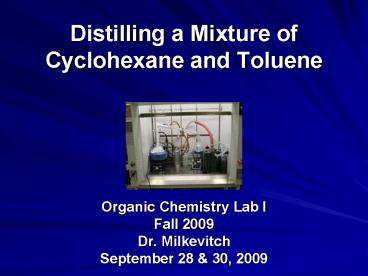Distilling a Mixture of Cyclohexane and Toluene - PowerPoint PPT Presentation
1 / 16
Title:
Distilling a Mixture of Cyclohexane and Toluene
Description:
Distilling high-boiling solvent, wrap distilling head and flask with foil to provide insulation ... Distill until 1-2 ml remains in the distillation flask ... – PowerPoint PPT presentation
Number of Views:653
Avg rating:3.0/5.0
Title: Distilling a Mixture of Cyclohexane and Toluene
1
Distilling a Mixture of Cyclohexane and Toluene
- Organic Chemistry Lab I
- Fall 2009
- Dr. Milkevitch
- September 28 30, 2009
2
Steps in a Chemical Synthesis
- Determine target compound
- Design synthesis (research reactions)
- Obtain starting materials equipment
- Assemble apparatus, begin synthesis
- Monitor complete synthesis
- Extract and isolate product
- Purify product
- Identify product (spectroscopic methods, physical
properties) - Assess success of synthesis
- Modify synthesis, continue work if necessary
3
Most Important Steps??
- Determine target compound
- Design synthesis (research reactions)
- Obtain starting materials equipment
- Assemble apparatus, begin synthesis
- Monitor complete synthesis
- Extract and isolate product
- Purify product
- Identify product (spectroscopic methods, physical
properties) - Assess success of synthesis
- Modify synthesis, continue work if necessary
4
Introduction to Simple Distillation
- Simple Distillation A purification method for
liquids, which involves the condensation of
vapors from a boiling liquid and collection of
those vapors in a receiving vessel
5
What occurs during a distillation
Water outlet/ inlet
6
Theory
- A pure liquid exhibits a vapor pressure that is
dependent on temperature - Thats why you can smell some fragrant liquids
Snif, snif
Liquid exerts a pressure at ambient temp/ pressure
7
When you heat a liquid
- Vapor pressure increases slowly
- Then, more rapidly near the boiling point
- More volatile liquids (e.g., diethyl ether)
exhibit higher vapor pressures at all temps
8
Definition of Boiling Point
- Boiling Point The temperature at which the
vapor pressure above the solution equals the
atmospheric pressure. - Lots of molecules in the air above liquid
- Equals atmospheric pressure
- Solution boils off
9
Common to distill mixtures of liquids
- Cyclohexane / toluene are an example
- Solution of cyclohexane / toluene boils when the
vapor pressure (Ptot) is equal to the atmospheric
pressure (Patm). - Contribution of each component to the total
pressure is called partial pressure - Patm Ptot Pcyclohexane Ptoluene
- Daltons law of partial pressures
10
Raoults Law
- Simple proportionality between solvent mole
fraction and its partial pressure at a given
temperature. - Partial pressure of a solution is the product of
the vapor pressure of the pure component (P?) at
a particular temperature and the mole fraction
(X) of the component. - Mole fraction the number of moles of a component
divided by the total number of moles of all
components
11
Raoults Law
- Partial pressure of cyclohexane
- Pcyclohexane P?cyclohexane Xcyclohexane
- Partial pressure of toluene
- Ptoluene P?toluene Xtoluene
- Therefore
- Ptot P?cyclohexane Xcyclohexane
P?toluene Xtoluene
12
Miniscale Apparatus for Distillation
13
Important Tips Concerning Miniscale Distillation
- Never heat a system the is totally closed from
the outside - Pressure builds up, can be very dangerous
- Never heat a system to dryness
- Explosion possible
- Do not overfill distillation flask (2/3 full max)
- Add boiling chips/ magnetic stir bar to reduce
bumping. - Do not add boiling chips/ stir bar while solution
is boiling (can bump because the chips/ stir bar
are cold ) - Place thermometer below neck of distilling head
- Water inlet is the lower condenser nipple, outlet
is upper nipple - Control rate of heating carefully (overheating
can cause bumping) - Hand hot plates carefully, for the tops get quite
hot - Distilling high-boiling solvent, wrap distilling
head and flask with foil to provide insulation - If BP gt150 C, you dont need to run water through
the condenser
14
Procedure
- Lay out glassware, check for cracks
- Pipet 10 ml each of cyclohexane and toluene into
a 50 ml RB flask - Add spin bar
- Assemble apparatus
- Connect water lines
- Have myself or your TA check apparatus
- Position the bulb of the thermometer below the
neck of the distillation head - Position the graduated cylinder below bent
adaptor - Turn on water slowly. You only need a slow
flow - Turn on heat to 6. Increase rate to 8 when you
see vapors contact thermometer bulb - Collect first few drops of distillate and discard
- Collect distillate at a rate 1-2 drops per second
- Record temperature vs. volume of distillate for
entire distillation - Take readings every 1-2 ml, or more frequently if
the temperature is going up rapidly - Increase heat as you proceed, because the
distillation pot will enrichen with toluene as
you proceed - Distill until 1-2 ml remains in the distillation
flask - Break down your apparatus, clean with soap/water
and put everything away
15
Final Notes
- Do not correct boiling points to std pressure
- Estimate and record the temperature ranges at
which fractions were collected, - estimate volumes of distillate collected at each
temperature - Graph boiling temp vs. volume (ml) of distillate
16
Questions to Answer
- 1) What is the relationship between volatility
and the vapor pressure of a solvent? - 2) Explain what happens to the vapor pressure of
a liquid as temperature increases. Are
temperature and vapor pressure directly
proportional? If not, explain the relationship
with a graph. - 3) Why is it preferable to allow cold water to
enter at the bottom of a condensor and exit at
the top rather than vice-versa? - 4) Can the vapor pressure of a liquid be greater
than 1 atm? Explain. - 5) What possible hazard might occur if a
distillation vessel is heated all the way to
dryness?































